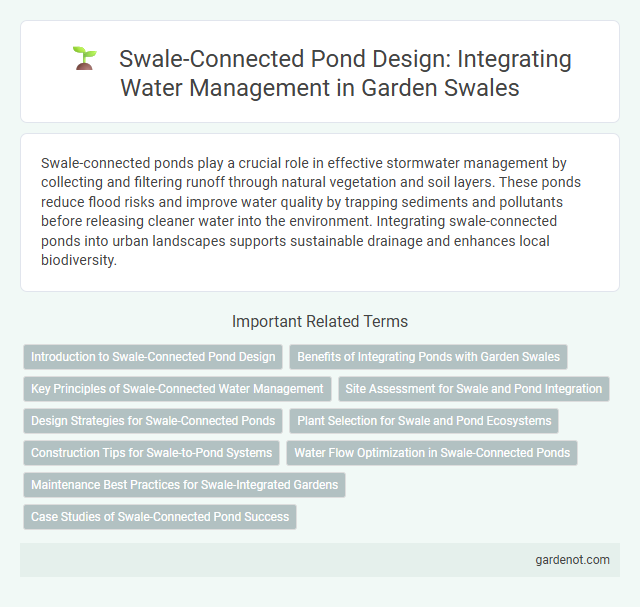Swale-connected ponds play a crucial role in effective stormwater management by collecting and filtering runoff through natural vegetation and soil layers. These ponds reduce flood risks and improve water quality by trapping sediments and pollutants before releasing cleaner water into the environment. Integrating swale-connected ponds into urban landscapes supports sustainable drainage and enhances local biodiversity.
Introduction to Swale-Connected Pond Design
Swale-connected pond design integrates shallow, vegetated swales with adjacent ponds to enhance stormwater management by promoting natural filtration and infiltration processes. This design optimizes pollutant removal, reduces runoff velocity, and supports groundwater recharge through strategically placed swales that direct flow into storage basins. Incorporating native vegetation within swales improves sediment capture and provides habitat benefits, making the system effective for sustainable urban drainage and watershed management.
Benefits of Integrating Ponds with Garden Swales
Integrating ponds with garden swales enhances water management by increasing water retention and reducing runoff during heavy rains, promoting groundwater recharge. This combination supports biodiversity by creating diverse aquatic and terrestrial habitats, benefiting pollinators and amphibians. The pond-swale system also improves nutrient filtration, reducing soil erosion and enhancing overall garden health and resilience.
Key Principles of Swale-Connected Water Management
Swale-connected ponds enhance surface water management by capturing and filtering runoff through vegetative swales that promote infiltration and reduce erosion. These systems rely on natural hydrologic processes to improve water quality, support groundwater recharge, and mitigate flooding by slowing water flow. Strategic design incorporates gradient control, native plantings, and sediment retention to maintain ecological balance and optimize stormwater treatment.
Site Assessment for Swale and Pond Integration
Site assessment for swale-connected pond integration involves evaluating soil permeability, topography, and hydrological flow patterns to ensure effective water retention and drainage. Detailed analysis of vegetation suitability and sediment transport helps prevent erosion and supports ecosystem balance. Proper assessment optimizes stormwater management, enhances groundwater recharge, and improves habitat connectivity within the landscape.
Design Strategies for Swale-Connected Ponds
Swale-connected pond design strategies emphasize effective water retention and controlled infiltration to enhance stormwater management and reduce runoff. Integrating biofiltration elements such as native vegetation and permeable soil layers improves pollutant removal and supports groundwater recharge. Proper grading and hydraulic connectivity between the swale and pond ensure optimal flow distribution and minimize erosion risks.
Plant Selection for Swale and Pond Ecosystems
Choosing native, water-tolerant plants such as sedges, cattails, and pickerelweed enhances the ecological function of swale-connected pond ecosystems by stabilizing soil and improving water quality. Incorporating diverse species like rushes and iris supports habitat diversity while facilitating nutrient uptake and sediment filtration within swales and ponds. Strategic plant selection promotes resilience against erosion and helps maintain hydrological balance in integrated swale and pond landscapes.
Construction Tips for Swale-to-Pond Systems
For effective construction of Swale-to-Pond systems, ensure the swale is graded with a gentle slope of 1-3% to direct water flow efficiently toward the pond. Use compacted clay or an impermeable liner at the pond base to prevent seepage and maintain water retention. Incorporate overflow outlets and sediment traps to manage excess water and reduce silting, enhancing the long-term functionality of the swale-connected pond.
Water Flow Optimization in Swale-Connected Ponds
Swale-connected ponds enhance water flow optimization by channeling runoff efficiently through graded, vegetated swales that reduce erosion and sediment accumulation. These swales facilitate the gradual infiltration and retention of stormwater, improving water quality and sustaining pond levels during dry periods. Integrating permeable surfaces and strategically placed inlet and outlet structures maximizes hydraulic performance while promoting groundwater recharge in swale-connected pond systems.
Maintenance Best Practices for Swale-Integrated Gardens
Maintaining a swale-connected pond requires regular inspection of water flow and sediment accumulation to prevent clogging and ensure efficient drainage. Vegetation management around the swale should focus on planting native, water-tolerant species that stabilize soil and reduce erosion. Periodic removal of debris and monitoring pond water quality are essential to maintain ecosystem balance and support healthy aquatic habitats.
Case Studies of Swale-Connected Pond Success
Swale-connected ponds have demonstrated significant success in managing stormwater runoff by enhancing water infiltration and reducing surface pollutants across urban and agricultural landscapes. Case studies reveal improved groundwater recharge rates and decreased flood risks, exemplified by projects in the Chesapeake Bay watershed and Melbourne's urban parklands. These findings highlight swale-pond systems as effective green infrastructure solutions for sustainable water management and ecosystem restoration.
Swale-connected pond Infographic

 gardenot.com
gardenot.com